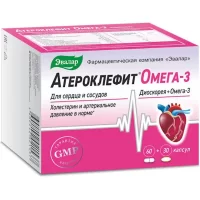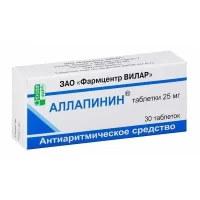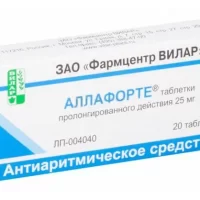Description
Digoxin Pharmacodynamics
Digoxin is a cardiac glycoside. It has a positive inotropic effect. This is due to a direct inhibitory effect of Na+/K+-ATP-phase on cardiomyocyte membranes, which leads to an increase in intracellular sodium ions and, consequently, a decrease in potassium ions. Increased content of sodium ions causes activation of sodium/calcium metabolism, increased content of calcium ions, resulting in increased strength of myocardial contraction.
Increased myocardial contractility results in increased blood stroke volume. Reduces terminal systolic and terminal diastolic volumes of the heart, which, along with an increase in myocardial tone, leads to a reduction in myocardial size and thus reduces myocardial oxygen demand. It has a negative chronotropic effect, reduces excessive sympathetic activity by increasing sensitivity of the cardiopulmonary baroreceptors. Due to the activity of the vagus nerve, it has an antiarrhythmic effect due to a decrease in the rate of impulse conduction through the atrioventricular node and prolongation of the effective refractory period. This effect is enhanced by direct action on the atrioventricular node and sympatholytic action.
The negative dromotropic effect is manifested by increased refractoriness of the atrioventricular (AV) node, which allows use in paroxysms of supraventricular tachycardia and tachyarrhythmias.
In atrial fibrillation tachyarrhythmia promotes deceleration of ventricular contractions, prolongs diastole, improves intracardiac and systemic hemodynamics. Positive butotropic effect is manifested when administering subtoxic and toxic doses.
It has a direct vasoconstrictor effect, which is most clearly manifested in the absence of congestive peripheral edema.
At the same time, indirect vasodilatory effect (in response to an increase in the minute blood volume and reduction of excessive sympathetic stimulation of vascular tone) usually prevails over the direct vasoconstrictor effect, resulting in a reduction of total peripheral vascular resistance (TPR).
Indications
Complex therapy of chronic heart failure class II (in the presence of clinical manifestations) and functional classes III-IV; tachysystolic form of paroxysmal and chronic atrial fibrillation and flutter (especially in combination with chronic heart failure).
Contraindications
Hypersensitivity to the drug, glycoside intoxication, Wolf-Parkinson-White syndrome, degree II atrioventricular block, intermittent complete block, ventricular tachycardia and ventricular fibrillation, lactation period (breastfeeding), children under 3 years of age, fructose intolerance, sucrose/isomaltase deficiency, lactase deficiency, lactose intolerance, glucose-galactose malabsorption.
With caution (comparing benefit/risk): Grade I atrioventricular block, sinus node weakness syndrome without an artificial pacemaker, possibility of unstable conduction through the atrioventricular node, history of Morgans-Adams-Stokes attacks, hypertrophic obstructive subaortic stenosis, isolated mitral stenosis with a rare heart rate cardiac asthma in patients with mitral stenosis (in the absence of tachysystolic atrial fibrillation), acute myocardial infarction, unstable angina pectoris, arteriovenous shunt, hypoxia, heart failure with impaired diastolic function (restrictive cardiomyopathy, cardiac amyloidosis, constrictive pericarditis, cardiac tamponade), extrasystole, marked dilatation of heart cavities, “pulmonary” heart.
Water-electrolyte disorders: hypokalemia, hypomagnesemia, hypercalcemia, hypernatriemia. Hypothyroidism, alkalosis, myocarditis, old age, renal and hepatic insufficiency, obesity, diabetes mellitus (the drug contains sucrose and glucose (dextrose monohydrate)).
Administration during pregnancy and lactation
Foxglove drugs penetrate the placenta. Digoxin on the safety of its use in pregnancy belongs to the category “C” (the risk of use is not excluded). Studies in pregnant women are insufficient, prescribing the drug
is possible only when the estimated benefit to the mother exceeds the potential risk to the fetus.
Digoxin is excreted in the mother’s milk. As there are no data about the drug effects on an infant during lactation, it is necessary to decide whether or not to stop breast-feeding if it is necessary to use it during lactation.
Directions for use and dosages
- Oral.
- As for all cardiac glycosides, the dose should be selected with caution, individually for each patient.
- If the patient before the appointment of Digoxin took cardiac glycosides, in this case, the drug dose should be reduced.
- Adults and children over 10 years of age
The dose of Digoxin depends on the need to achieve a rapid therapeutic effect.
Moderately rapid digitalis (24-36 h) is used in emergency cases
The daily dose is 0.75 to 1.25 mg divided into 2 doses, with ECG monitoring before each subsequent dose. - After saturation is achieved, switch to maintenance treatment.
Slow digitalization (5 to 7 days).
A daily dose of 0.125 to 0.5 mg is administered once daily for 5 to 7 days (until saturation is achieved), then switch to maintenance treatment.
Chronic heart failure (CHF) - In patients with CHF Digoxin should be used in small doses: 0.25 mg per day (for patients with body weight more than 85 kg up to 0.375 mg per day). In elderly patients, the daily dose of Digoxin should be reduced to 0.0625 – 0.125 mg (1/4; 1/2 tablet).
- Children between 3 and 10 years of age.
The saturating dose for children is 0.05 to 0.08 mg/kg/day; this dose is administered for 3 to 5 days for moderately rapid digestion or for 6 to 7 days for slow digestion. The maintenance dose for children is 0.01 to 0.025 mg/kg/day. - Impaired renal function
In patients with impaired renal function it is necessary to reduce the dose of Digoxin: at creatinine clearance (CK) value of 50 – 80 ml/min the average maintenance dose (AMD) is 50 % of the AMD for patients with normal renal function; at CK less than 10 ml/min – 25 % of the usual dose. - Moderately rapid dosing (24-36 h) is used in emergency cases
The daily dose is 0.75-1.25 mg divided into two doses, with ECG monitoring before each subsequent dose. - After saturation is achieved, switch to maintenance treatment.
Slow Digitalization (5-7 days).
A daily dose of 0.125-0.5 mg administered once daily for 5-7 days (until saturation is achieved), after which switch to maintenance treatment. - Chronic heart failure (CHF)
In patients with CHF, digoxin should be used in small doses: up to 0.25 mg per day (for patients with body weight more than 85 kg up to 0.375 mg per day). In elderly patients, the daily dose of digoxin should be reduced to 0.0625-0.125 mg (1/4; ½ tablet).





